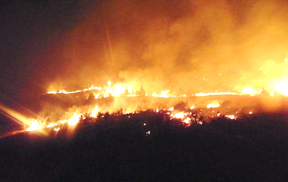The Rattlesnake Springs fire in late July burned across about 10,000 acres of reservation land, including range land.
No structures were destroyed and no one was injured, but the consequences are still serious. The loss of grazing land and the increase in non-native invasive weeds are two examples.
These and other issues came up at Tribal Council when Fire Management and Forestry gave their report on the Rattlesnake Fire.
Discussion included the cooperative agreement by which the tribes are reimbursed by the federal government for the cost of fighting fires that happen on the reservation.
Under investigation
The cause of the Rattlesnake Springs blaze was still under investigation this week. There is evidence, though, that the blaze was human-caused.
A person can be held financially and criminally liable for causing a wildfire. This happened two years ago when a woman was sentenced to 18 months in prison for starting the Sunnyside Turnoff fire.
Meanwhile last month, about 250 fire fighters helped contain the Rattlesnake Springs blaze. There was air support—a helicopter and single-engine air tanker—through the Central Oregon Interagency Dispatch Center.
The blaze broke out on Sunday afternoon, July 24, in the area of Rattlesnake Springs, near a swimming hole at the Deschutes River.
Over the following days, the fire burned up to Webster Flat and the Culpus Bridge areas, near the Kah-Nee-Ta Golf Course. Some homes were threatened, but the fire crews were able to keep the flames away from the structures.
Still, residents were adversely affected: The fire burned across grazing land, including 360 acres that a resident was planning to use for his cattle later this summer.
All but 10 of the 360 acres were consumed, said Orvie Danzuka, of tribal Forestry. Danzuka and Trey Leonard, Fire Management Officer, updated the Tribal Council on the situation last week.
A question was whether there is a program that can provide some relief to the individual whose grazing acreage was burned. In the past the OSU Extension program has provided some help, said Bodie Shaw, acting BIA superintendent for the Warm Springs Agency.
Extension Agent Scott Duggan said he would look into the potential programs—such as through the Department of Agriculture—that may be available.
Invasive species
Trey Leonard brought up the subject of invasive weeds such as cheatgrass and medusa head. Both of these are non-native plants brought here decades ago from Europe.
When a fire burns across rangeland on the reservation, Leonard said, the result often is an invasion by the non-native species. The native plants such as bunch grass lose habitat.
“Medusa head and cheatgrass take over each time we have a fire,” Leonard said. The BLM has a successful program of planting bunch grass following fires, he added.
The tribes could implement a similar program, and Leonard said he would be in contact with the BLM regarding their program.
Reimbursement
The federal government is responsible for the cost of fighting wildfires that happen on federal land, or trust land in the case of the reservation.
Through a self-governance compact with Department of the Interior, the tribes’ Fire Management teams will respond to the fire. Invoices for the costs—personnel, equipment, etc.—are then submitted to the federal government for reimbursement through a fire suppression account.
This issue came up at Council last week, as the fire reimbursement agreement between the tribes and the federal government had expired on June 30, following a two-year extension of the earlier agreement.
The matter was then quickly addressed, with the parties agreeing to the terms of a renewed agreement.


